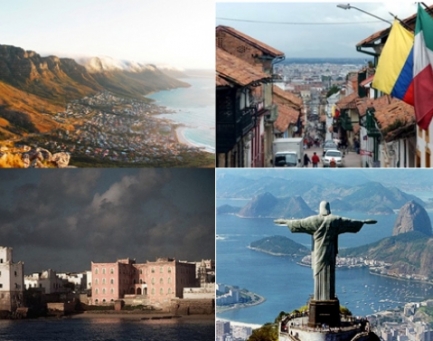Drug trafficking, weapon trading, child slavery, disease infestations and organ harvesting are common occurrences in various pockets around the globe. These towns are run by the world’s most corrupt officials, populated by the world’s worst criminals and yet, sport some of the most stunning tourist attractions ever seen. What follows is a list of not only the world’s most dangerous thug occupied towns, but an insight into the fascinating culture clashes that us office hermits tend to forget.
Cape Town, South Africa
As the cultural centre of South Africa, Cape Town is undeniably beautiful. Located on the South Coast, the town is ranked the number 1 in the 2011 Travellers Choice tourist destinations. Yet, underneath this spectacular scenery, lies polarised wealth separations, which is often the result in a particularly high crime rate. Car hijacking is predominantly popular in Cape Town, along with the congregation of gangs, often to do with drug and weapon relations. Whilst the centre of Cape Town is wealthy largely due to excellent tourism, the fringe suburbs around the city such as Greenpoint, Salt River and Mowbray are poor and unsanitary. One of the most dangerous areas of Cape Town is Nyanga, with a staggering unemployment rate of approximately 70%, as well as constant breakouts of HIV AIDS amongst its residents. Caution must also be taken when using ATM’s as theft is common and attacks on tourists remain high. That being said, travelling is about getting out of our comfort zones, seeing the world that other people live in. As long and you keep your wits about you and don’t wander off alone, there’s no reason why this glorious city should be crossed off any ones bucket list.
Bogota, Colombia
Often referred to the drug capital of the world, Colombia is viciously affected by the ever growing trade of buying and selling drugs. This industry has had an immense impact upon drug related crimes, political turmoil and societal disturbance in its capital Bogota. Like all places, there are lovely regions of Bogota. The food is excellent and the views, like you can see in the picture, are spectacular. Yet it still remains the most dangerous city in South America. Situations have improved since the 1990’s especially in the north of the city, yet political warfare and issues with drug trading continue to linger within Bogota and its southern slum regions. Hopefully things will continue to improve down into the southern regions of Bogota, like they have in the North. Political rebel groups are still very powerful and kidnapping of tourists by similar groups is not uncommon. It is important to avoid highways on the fringe cities of Bogota as they are prime capturing regions and once kidnapped, authorities have little power and facilities to assist tourists in danger.
Mogadishu, Somalia
Somalia, on the south east coast of Africa suffers from the violence of civil warfare and as a result has left its capital, Mogadishu, a disaster zone. The country is extremely dangerous, particularly due to its constant battles with bordering country Ethiopia. Because of this ongoing battle, over half the city’s population has fled to safer African countries where bombings, gunshots and riots aren’t a daily occurrence. Those who chose to remain in the city have filled and now overflow local hospitals and refugee camps due to stray bullets and bomb explosions. In 2009 there was a significant increase in violence and suicide bombings, which had been a rare occurrence in the past and have left the streets in shambles with little remaining buildings. The city is unsafe for tourists and not a recommended holiday destination. Witnessing this third world country’s culture contrast is not worth the risk of your safety.
Rio de Janeiro, Brazil
Famous for Baz Lurhmann’s Romeo and Juliet, the city of Rio de Janerio is almost as dramatic as the film. Civil gun wars are not uncommon, with approximately 30 people murdered a week, a lot of them the result of stray bullets and muggings. A lot of these issues can be derived from the cities gap between rich and poor of society with about 20% of Rio’s population living in shanty towns and slums. As the police in the city are often found to be corrupt, their pay is minimal which results in authorities threatening for bribery. It is common for tourists and locals to be framed for drug related crimes, leaving victims with bribery as their only option. Despite its corruption, Rio de Janeiro is the most visited city in southern hemisphere and is known for its natural settings. The city’s beaches like Copacobana and Barra da Tijuca are particularly famous and are highly popular during a Brazilian summer. The famous Christ the Redeemer landmark is shown numerous times throughout Romeo and Juliet and protrudes from Sugaloaf Mountain.The City remains one of the top tourist destinations and despite crime rates; it continues to be safe enough for sun loving travellers from all around the world.
As a traveller, it is important to keep in mind boundaries. Some we must push past, others desereve respect. It is the proper acknowedgement of what boundaries must be broken to have an amazing trip, and which are too great and therefore should be left well alone, that makes not only a smart traveller, but an alive one.









